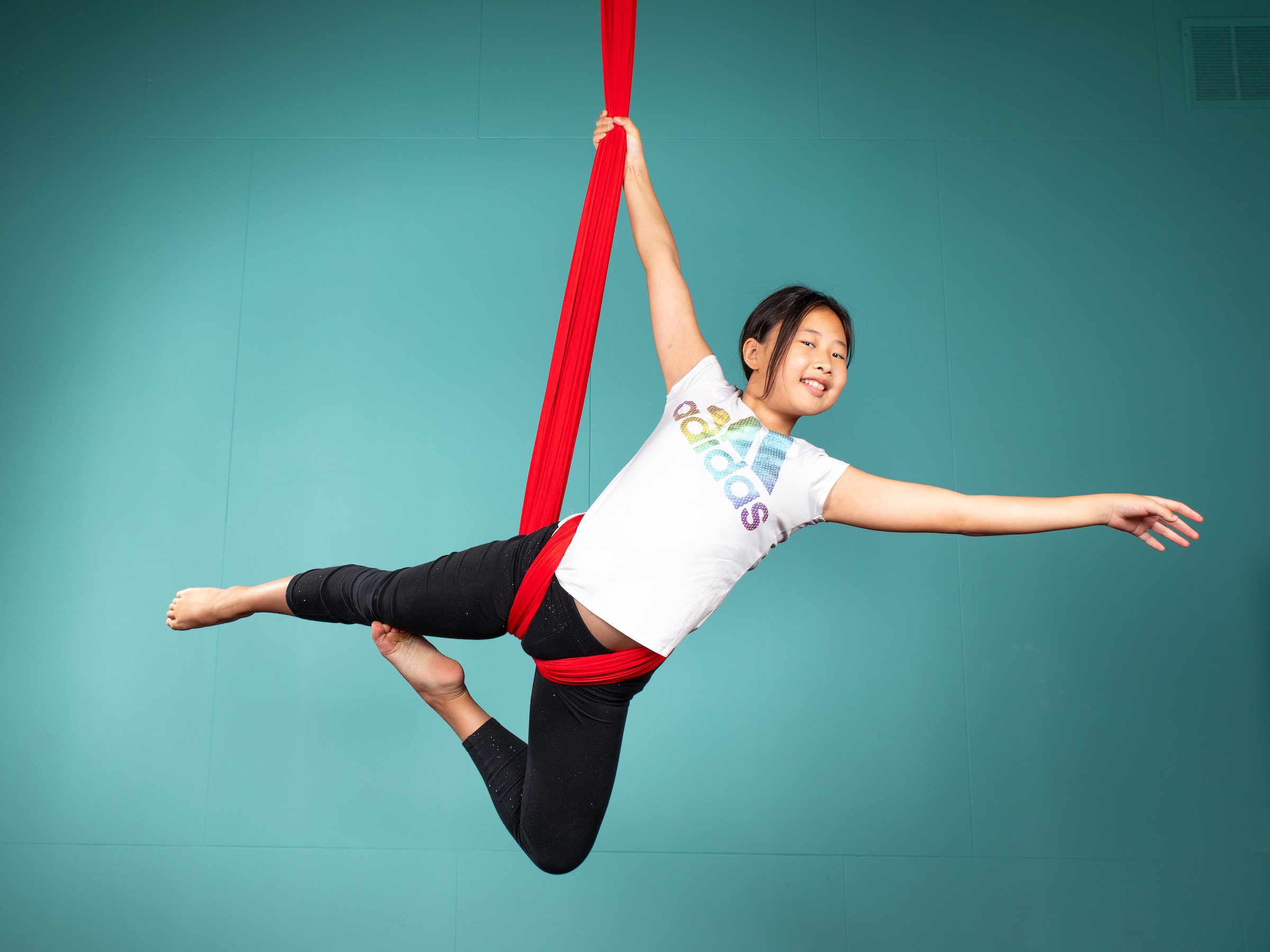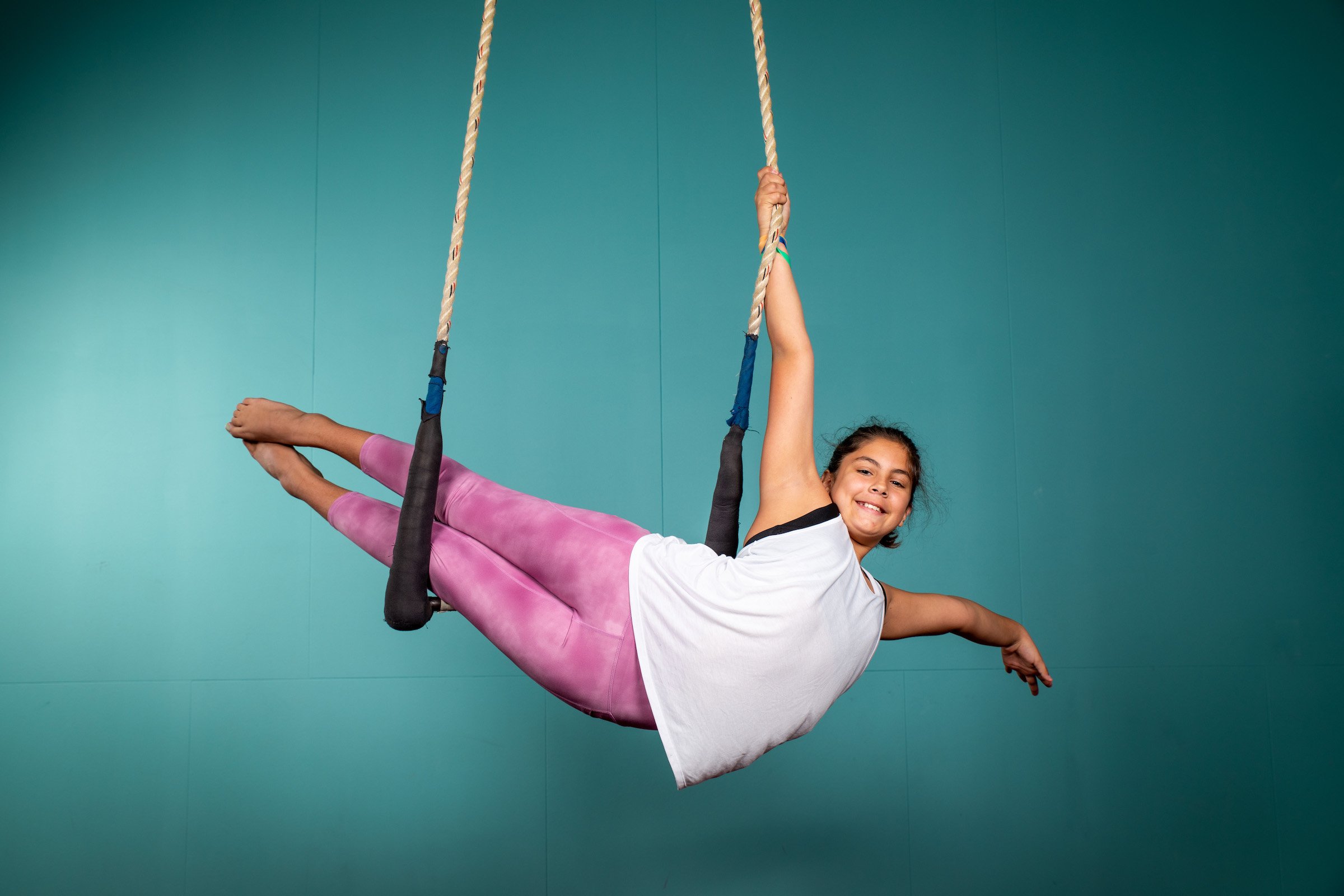
Apparatus, Levels, and Prerequisites
Are you and your children new to the world of aerial and circus arts and wanna learn more? You’ve come to the right place!
Is your kid a Sky Candy regular (or joining us from another studio) and wants to know what level to start at / go to? You’re also in the right place!
If you have any other questions, many of them are answered the FAQ on our Getting Started page.
Here at Sky Candy, we believe that circus is for every body. We welcome youth and teen students of all backgrounds to join the Beginner level of any apparatus. This page offers one easy spot to learn about all of the different apparatus and disciplines we teach, our leveling system, and class prerequisites. Currently we teach the “core four” apparatus in our kids classes in Austin, TX: silks, trapeze, sling, and lyra. Unlike graduating from grades in school, our levels are designed to be taken as many times as a student needs to before advancing with the majority of our students taking multiple rounds of a semester long series class before advancing to the next level.
Silks
Silks (also known as aerial silks, fabric, or tissu) is one of the most popular aerial apparatus. Silks hang in two long strands from a single point in the ceiling and students will learn how to climb, wrap, suspend, and drop as they build core and upper body strength developing their skills. This apparatus is great for folks who enjoy puzzles and problem solving!
-
Prerequisites
No prerequisites to enter
Goals
Climb and descend the apparatus comfortably using basic techniques
Learn footlocks and footlock shapes on the ground and begin executing those skills in the air
Learn and master short arm inversions on the ground and begin executing those skills in the air
Learn the mechanics of supported inverted skills using knee hooks, lever action, and wraps
Learn basic pathways to S and U wraps
Get comfortable with fundamental positions and shapes, including gazelle, straddle, arabesque, hipkey, front balance, crucifix, crochet, and more
-
Prerequisites
10 second long and short arm hang with hollow body
Russian and standard climbs - able to climb 16 ft.
Single and double footlocks in the air (figure 8 and aerial dance)
Footlock roll-ups and arrow
Split pole (tuck & straddle/frog) and single pole inversions (straddle/frog) from the ground
Inversion in the air (tagging okay)
10 second inverted straddle hold with poles together and with poles apart
Hip key from Russian lean
Clear understanding of same side and opposite side knee hooks
Single same side knee hook climb & exit
Controlled catcher’s descent
S Lock from catcher’s keyover / shoofly
Cross catcher’s → U Lock
Endurance in the air (1 minute)
Goals
Learn closed wrap drops & dives that move through space forwards, backwards, sideways, and down
Develop and apply understanding of S & U wrap theory and its accompanying movements
Develop and apply understanding of outside knee hook family and its accompanying movements
Learn rotational movements around a fixed point, including windmill, BBQ/legocopter, J-flip, etc
Develop endurance for executing multiple inversions in the air and sequencing familiar skills
Introduce C shaping, including specific work on back balance skills
Work on more advanced conditioning drills for skills such straight leg fankick hipkey, one arm hang, flags, meathooks, and skin the cat
Introduce beats and build long arm inversion strength
Learn skills with more complex entry and exit options, including belay
-
Prerequisites
Crossback straddle
Any entry to belay
Windmill (frog is okay)
Single star
Salto
Back balance (controlled entry, hand spot okay)
Endurance in the air (3 minutes)
BBQ / legocopter / single thigh rotations
Consistently clean straight leg inversions in air throughout class
Fankick hipkey
Multiple inversion knee hook climb
360 Drops (forward and backwards)
Goals
Expand on existing drop vocabulary to learn more complex and challenging wrapped drop variations, drops that change direction while falling, dynamic drops, and open drops
Explore skills that utilize meathook and skin the cat pathways
Learn more complex, dynamic pathways to familiar skills
Apply beats to dynamic skills and transitions and C shaping to rollups
Develop endurance for longer sequences of more advanced skills
Apply aerial theory to finding new pathways into familiar skills
Develop and apply understanding of inside knee hook family and its accompanying movements
Lyra
Lyra (also known as aerial hoop) is a metal apparatus (generally made from solid or tube steel). We have lyras in a wide variety of sizes to fit students of all heights, shapes, and abilities. Students learn how to invert, spin, pose, and transition as they core and upper body strength. This is a great apparatus for folks who love to spin!
-
Prerequisites
No prerequisites to enter
Goals
Build strength and comfort in hanging positions
Enter the lyra unassisted
Master foundational skills in and below the hoop
Move safely into and out of a hip hang
Demonstrate the basics of knee beats
Demonstrate control of the lyra during mounting and exiting
Familiarity with spinning
-
Prerequisites
Side entrance
Straddle entrance (tag okay)
Knee beats
Pike under the bar (top or bottom)
Gazelle
Mermaid
Transition into and out of hip drape
Wineglass
Dragonfly
Front balance (hands on okay)
Straddleback
Top bar knee hang and safe exit
Goals
Build strength in short arm positions, inversions, balances, and skills with one point of contact
Learn dynamic movements: beats, rolls, and small drops
Learn to use beats for dynamic skills and transitions
Build spin tolerance
Learn technique and build strength in long arm inversions and flares
Begin to sequence skills together and build endurance
-
Prerequisites
Straddle inversion and hold
Pullover
Front Balance (hands free)
Ankle Hang
Back Balance (hands free)
Amazon
Skin the Cat
Sitting → Single Hip Hang
Beat to sit
Single Arm, Elbow, and Knee Hang
Flag
A drop of student’s choice
Long beats and pike beats
Goals
Learn advanced hangs, balances, and half and full release skills
Expand repertoire of dynamic skills and rolls
Develop endurance for longer sequences of more advanced skills
Increase spin tolerance and strength in long arm inversions
Sling
Sling (also known as aerial hammock) is a loop of fabric with endless possibilities! For new-to-aerial students, sling is an accessible starting point to begin your journey and for more experienced students, sling offers a huge variety of movement opportunities that may feel familiar to skills you’ve worked on in silks, lyra, or trapeze. This is a great apparatus to start or deepen your aerial journey!
-
Prerequisites
No prerequisites to enter
Goals
Learn inversions from the ground
Learn foundational positions and their facets, including straddleback, horse, knee hooks, front balance, hipkey, catcher’s, seatbelt, and how to transition in and out of them
Develop standing skill vocabulary
Explore open sling shapes and skills
Introduce and develop comfort with simple dives and drops (forward dives, pops)
Introduce dynamic movement (knee beats, crucifix beats)
Sequence basic skills
-
Prerequisites
Short arm straddle and tuck inversions from standing on the ground
Knee beat
Pullover to front balance
Catcher’s
Hipkey
Arabesque on single pole
Triangle
Single leg roll up
Catcher’s dive of choice
Seatbelt entrance of choice
Sequence 5 skills of student’s choice in a row
Goals
Introduce relational theory (how skills transitions between each other, for example with catcher’s, seatbelt, and hip/thigh corsets)
Learn more simple drops and dives that move backwards, sideways, and straight down through space
Introduce C shaping, including specific work on back balance skills
Continue work on beats and learn new pathways
Learn rotational movements around a fixed point, including BBQ, J-flip, etc
Master aerial inversions and develop skills in the poles/ropes
Work on more advanced conditioning drills for skills such one arm hang, flags, meathooks, and skin the cat
-
Prerequisites
Clean aerial inversion (tuck and straddle) throughout class
Forward, pike, and bell beats
Hip corset entrance of choice
Thigh corset entrance of choice
Slow BBQ/rotisserie
Crossback straddle
Horse arounds / beauty rolls in both directions
Scissor roll
Back dive
Sideways moving drop/dive of choice (hipkey, secretary, peter pan, cartwheel)
Endurance in the air (3 minutes)
Goals
Continue working on skills in the poles/ropes
Apply C shaping and dynamic movement in familiar skills and new pathways
Expand on existing drop vocabulary to learn more complex and challenging wrapped drop variations, drops that change direction while falling, dynamic drops, and open drops
Develop long arm inversion strength
Experiment with more challenging variations and longer sequences using previously established skills
Expand repertoire of dynamic skills and rolls, including new beat variations
Trapeze
Trapeze (also known as static trapeze) is one of the most iconic aerial apparatus. Made up of two ropes and a steel bar, this apparatus is beautifully versatile with accessible skills for new students and challenging dynamic movements for experienced students. Part “soft apparatus” and part “hard apparatus”, trapeze is a great apparatus if you want to explore aerial movements where you move around your apparatus and where your apparatus moves around you!
-
Prerequisites
No prerequisites to enter
Goals
Find ease and balance in, into, and out of neutral positions (long arm hang, sit, stand, hip drape, knee hang)
Learn and master foundational positions and their facets/points of contact, including gazelle, mermaid, coffin, hip drape, straddle back, knee hang, bat hang, and how to transition in and out of them
Discover pathways through rotations (sit to hips/hips to sit)
Master foundational skills on and below the bar
Learn the basics of momentum skills, including long, pike, and knee beats
Learn how to independently get to high bar (rope climb, jump, etc)
While this class is mostly taught on static trapeze, we will also introduce single-point trapeze.
-
Prerequisites
Able to invert without assistance through a pullover and a tuck or a straddle
Knee beats
Gazelle
Mermaid
Transition into and out of hip drape (via rotation)
Dragonfly
Front balance
Straddleback
Bat hang
Standing side balance
Arabesque
Lijanna
Ankle hang with spotting rope
Able to safely get onto a high bar without assistance
Beginner Up/Down: Tuck or straddle onto bar, rock n’ roll to sit, perch to stand, stand on demi-pointe, return perch, straddle/trashcan exit, straddle out
Goals
Develop transitions above/below bar
Continue work on beats, learn new pathways and learn to use beats for dynamic skills and transitions
Introduce more dynamic movements including rolls/rotations, slides, and small drops
Build strength in short arm positions, inversions, balances, and skills with one point of contact
Begin to sequence skills together and build endurance
Introduce relational theory (how skills transitions between each other)
Master aerial inversions and develop skills in the ropes
Work on more advanced conditioning drills for skills such toe hangs, heel hangs, single knee hang, one arm hang, meathooks, and skin the cat
-
Prerequisites
Aerial inversion (straddle and tuck)
Single crochet (both sides)
Ankle hang
Single knee hang (both sides)
Long and pike beats
Single arm hang (both sides)
Crucifix
Skin the cat
Intermediate Up/Down: Pullover on the bar to hip drape to front balance to no hand drop to catcher’s to straddle to knee beat to pop to sit to ankles to long arm straddle down
Goals
Learn advanced hangs, balances, and half and full release skills
Expand repertoire of dynamic skills and rolls and drops
Develop endurance for longer sequences of more advanced skills
Develop strength in long arm inversions
Explore more skills in the ropes
Learn and apply C shaping
Develop a personalized vocabulary of transitions and shapes
About Class Levels
Classes at Sky Candy are all about progressions. Each class is designed around a number of core concepts, listed as “Goals” in the table below. These core concepts develop from one level to the next. In each 5-week or 10-week series, your teacher will work with you through a selection of skills, drills, and transitions from that level’s curriculum.
Series classes are split out into Beginner, Intermediate, and Advanced. For most apparatuses, Beginner classes have no prerequisites and are open to those with no experience. Our main notable exception is Straps, which is a more demanding apparatus that has requisite strength requirements to start due to its steep learning curve and its intense demands on the body.
It’s All About the Journey
It can be easy to see a list of levels as a ladder to climb as quickly as possible, but we encourage students to let go of expectations about how long it will take them to graduate from a level. Everyone moves at their own pace, and progress isn’t always linear. Students are welcome to move back to a previous level after taking a break, recovering from injury or illness, or just to refresh fundamental skills in a less advanced class.
We use the prerequisites listed below as a quick guide to what you’ll need in the next level, but your teacher always has the final say on when you advance.
Mastery And Why Is It Important
You’ll see that many prerequisites ask for “mastery” of particular skills. We define mastery as:
Ability to execute a skill independently
Without cues or demos (verbal or physical)
Without spotting
Solid form / technique
Safe entry and exit from the skill (not just getting to the skill at any cost)
Performed in a manner that is safe, efficient, and repeatable one’s body
Understanding and awareness of facets/points of contact and where your body is in space while executing skill
Why is skill mastery important for advancement?
Good form now opens up students to more easily transitioning to more advanced progressions
Minimizes risk of injury
Gives students the freedom to make aesthetic choices
Efficiency in movement ensures longevity in the activity
About Class Levels




